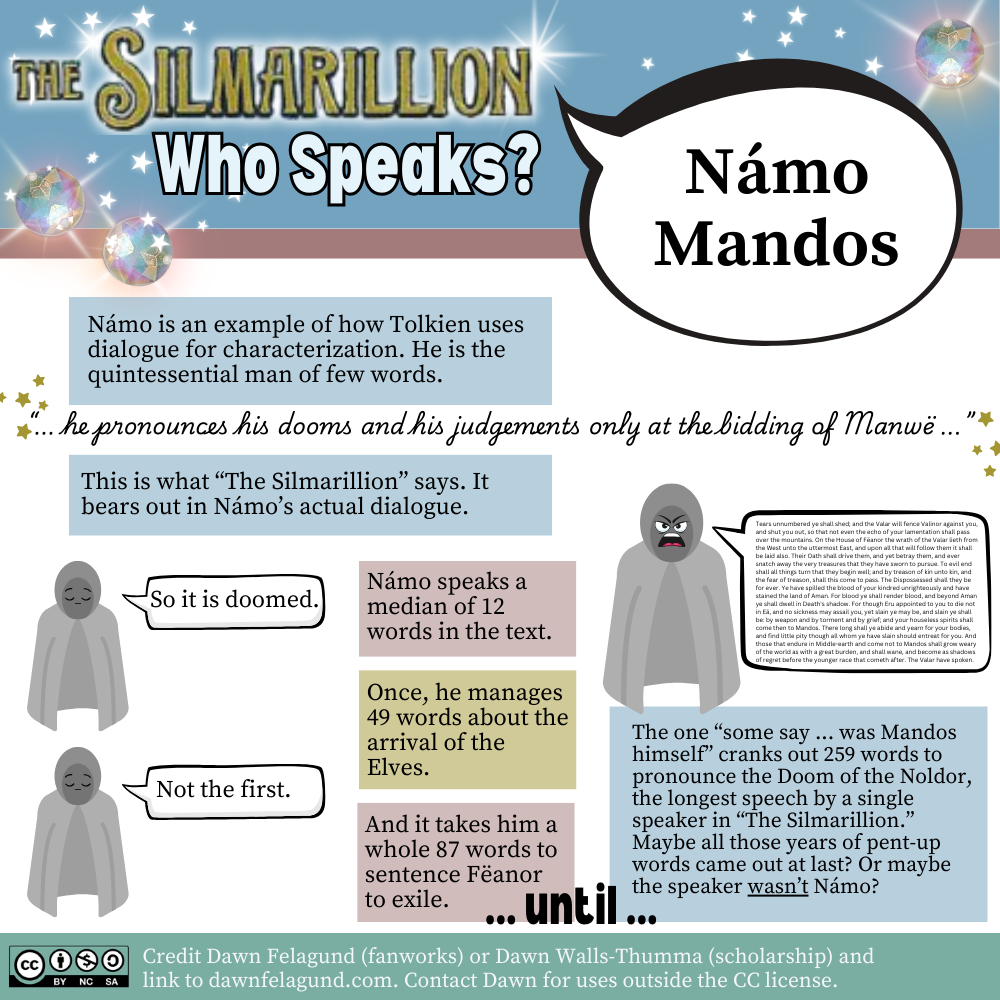New Challenge: Musicals
Prompts this month come from musicals.
The Silmarillion: Who Speaks? by Dawn Felagund
Námo Mandos

We don't often think of The Silmarillion as a text that uses modern literary strategies, like indirect characterization through dialogue. However, Tolkien absolutely characterizes using dialogue. Some characters have distinctive patterns in their dialogue, for instance. Námo Mandos is one such character.
Námo is a man of few words. The Silmarillion states that he speaks his judgments at the bidding of Manwë ... not only that, but he speaks very few words, even when pressed to do so.
Námo speaks eight times in the text with a median of twelve words per instance of dialogue. Across the entire book and all characters, the median number of words per instance of dialogue is thirty-one words, so Námo is well below average.
Until he isn't. As the Noldor leave Aman, "they beheld suddenly a dark figure standing high upon a rock that looked down upon the shore. Some say that it was Mandos himself, and no lesser herald of Manwë" ("Of the Flight of the Noldor"). This guys churns out 259 words, more than three times his next longest speech and twenty-one times longer than Námo's median dialogue length. It is the longest dialogue by a single speaker in The Silmarillion.
What is happening here? There are a few possibilities:
- Tolkien uses this single long speech in contrast to Námo's seven other much shorter instances of dialogue to emphasize the importance of this speech. Along those same lines,
- the Doom of the Noldor, along with the Oath of Fëanor, form the "explanation of history" used by the narrator of The Silmarillion. Just about everything bad that happens, the narrator finds a way to tie back to these. Again, the length of the speech—especially coming from a character who is succinct verging on terse—emphasizes the centrality of the Doom of the Noldor. We understand that Námo only speaks when it's important, and he says a lot here, so it must be really important.
- Is the speaker even Námo? The language "some say" creates doubt; it relegates the identity of the speaker to the realm of rumor. Again, thinking about the narrator, the uncertainty allows for the possibility that the narrator elevated a theory that confirms his understanding of history without having firm evidence.
- Or maybe the anomaly is a characterization strategy. Tolkien writes a character who speaks very little. In this scene, he speaks a lot. And I do mean A LOT. What does this say about Námo's frame of mind in this scene? He suddenly unleashes a torrent of dialogue where he spoke minimally or not at all before, perhaps an indication of distress, sorrow, frustration? It is further interesting, considering that his second longest instance of dialogue was also Fëanor-related, to consider what this shows of his feelings toward Fëanor. Is this the Silmarillion version of the modern comedy trope where the strong, silent type suddenly lets loose the outpouring he's been holding in all this time?
Regardless of the theory you prefer, Tolkien uses dialogue here to raise questions about characters and about history.

